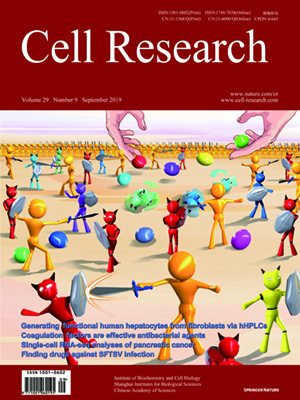
Volume 29, No 9, Sep 2019
ISSN: 1001-0602
EISSN: 1748-7838 2018
impact factor 17.848*
(Clarivate Analytics, 2019)
Volume 29 Issue 9, September 2019: 767-769
LETTERS TO THE EDITOR
Multivalent m6A motifs promote phase separation of YTHDF proteins
Yifei Gao 1, Gaofeng Pei 1, Dongxue Li 1, Ru Li 1, Yanqiu Shao 2, Qiangfeng Cliff Zhang 2 and Pilong Li 1
1 Beijing Advanced Innovation Center for Structural Biology, Beijing Frontier Research Center for Biological Structure, Tsinghua-Peking Joint Center for Life Sciences, School of Life Sciences, Tsinghua University, Beijing 100084, China and 2MOE Key Laboratory of Bioinformatics, Tsinghua-Peking Joint Center for Life Sciences, Beijing Advanced Innovation Center for Structural Biology, School of Life Sciences, Tsinghua University, Beijing 100084, China
These authors contributed equally: Yifei Gao, Gaofeng Pei, Dongxue Li
Correspondence: Pilong Li (pilongli@mail.tsinghua.edu.cn)
Dear Editor,
Posttranscriptional modifications of coding and non-coding RNAs are prevalent in cells. N6-methyladenosine (m6A) is the most abundant type of modification on eukaryotic messenger RNAs (mRNAs).1 This modification plays important roles in multiple fundamental biological processes, for example, cell differentiation, tissue development and tumorigenesis.2,3 Like many other chemical modifications on biological macromolecules (proteins, DNAs, and RNAs), m6A can also be recognized by specific reader domains. The best-studied m6A reader domain is the YT521-B homology (YTH) domain, which is conserved from yeast to human and preferentially binds to a RR(m6A)CU (R = G or A) consensus motif.4,5,6,7 Humans have five proteins containing a YTH domain, of which three, YTHDF1-3, belong to the same protein family, the DF family.7 In addition to the well-folded YTH domain at their C-termini, all three proteins also have a low complexity domain (LCD) at their N-termini (Fig. 1a). Their LCD regions are predicted to be Prion-like domains (Fig. 1a). Prion-like domain-containing proteins often have the potential to undergo phase separation.8 Phase separation is often found to contribute to biomolecular condensation.9 Indeed, the LCDs of all three YTHDF proteins (Fig. S1) underwent concentration-dependent phase separation in the absence of RNA (Fig. 1b and S2). The resulting condensates exhibited liquid properties as two or more droplets can grow into a much larger droplet (Fig. S3a). Full-length YTHDF1/2/3 proteins (Fig. S1) also underwent phase separation under physiological conditions in the absence of RNA, although their capacity for phase separation was decreased in comparison with their LCDs (Fig. 1b and S3b).
https://doi.org/10.1038/s41422-019-0210-3
FULL TEXT | PDF
Browse 1253


